It looks like you're using an Ad Blocker.
Please white-list or disable AboveTopSecret.com in your ad-blocking tool.
Thank you.
Some features of ATS will be disabled while you continue to use an ad-blocker.
13
share:
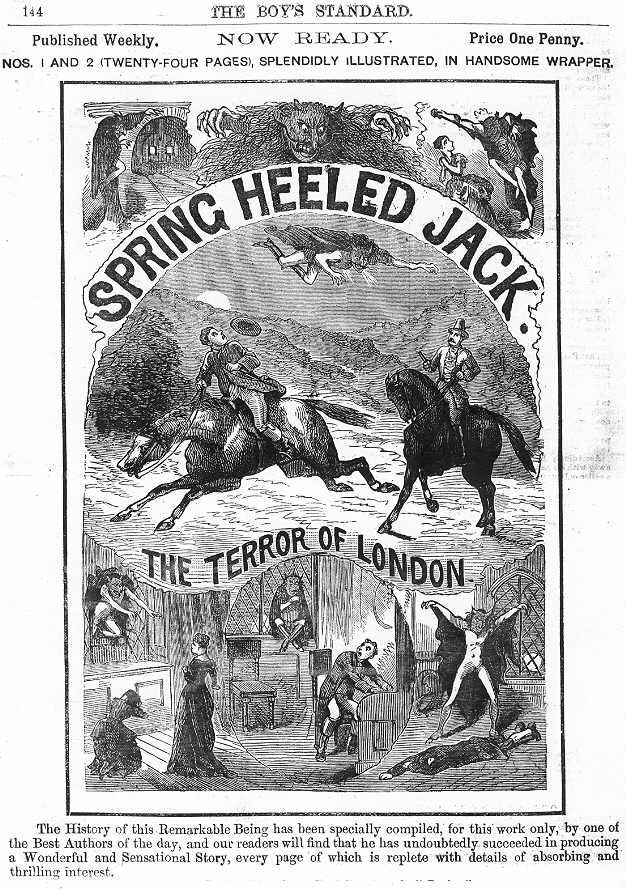
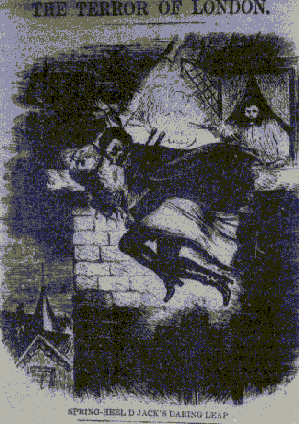
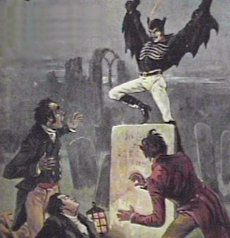
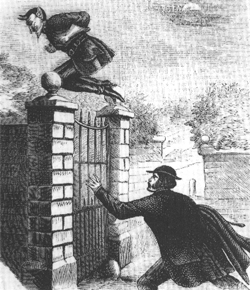
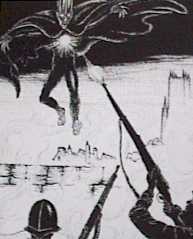
Spring Heeled Jack is an old legend that dates back to the Victorian era. The first claimed sighting was in 1837. Later sightings were all over England and most prominent in suburban London, the Midlands and Scotland. He is said to have a "Devil like" diabolic appearance with clawed hands, red eyes and he always wore a black cloak. He got his name because he could leap really high. Some say that he maybe some sort of Demon and others say that he maybe some kind of Extraterrestrial being, while others think that he is some Paranormal entity from another dimension.
Here is the Legend of Spring Heeled Jack:
One of the most curious and persistent of all paranormal creatures is Spring Heeled Jack. Reports of his existence date back to the early 19th century in Sheffield, England, and he has been reported on and off in England and the US as recently as 1995. A similar apparition, called "La Viuda," or "the widow" was reported in Chile in the 1940s and 50s, though he seemed to have been motivated by theft as much as mischief. And while a decent case can be made that the legend of Spring Heeled Jack is nothing more than a series of cruel hoaxes, it would represent a conspiracy of impressive scope and durability. And while his story changes from source to source, it goes something like this… In 1808, a letter to the editor of the Sheffield Times recounted how "Years ago a famous Ghost walked and played many pranks in this historic neighbourhood." The writer went on to identify this entity as the "Park Ghost or Spring Heeled Jack," and briefly described its ability to take enormous leaps and frighten random passers-by, but concluded, "he was a human ghost as he ceased to appear when a certain number of men went with guns and sticks to test his skin." Spring Heeled Jack would often go underground when the going got too rough, and he often unchivalrously pitted himself against women. In 1837, SHJ appeared to Polly Adams and two other women outside Blackheath Fair. With iron tipped fingers, he tore the blouse off of Adams and scratched her stomach before bounding into the darkness. According to some accounts, Adams described her assailant as "Devil-like," and according to others, she described him as a "pop-eyed" nobleman-perhaps Henry de la Poer Beresford, Marquis of Waterford. When in 1838, the Lord Mayor, Sir John Cowan publicized this and other assaults, he was besieged by letters by citizens who had suffered similar incidents but were too sheepish to make them public. Vigilante groups were formed to apprehend Jack, but he was quick, could leap over hedgerows and walls, and evaded them easily. After a while, the countryside attacked ended, the matter was dropped, and nobody was prosecuted. But later that year as Lucy Scales (or "Squires") and her sister walked home on a London street, Jack jumped out of the shadows and spat blue flames in her face, temporarily blinding her, then retreated into the darkness. This attack and others were widely reported by the press, so when Jane Alsop heard a knock at the door and the words, "I'm a police officer-for God's sake, bring me a light, for we have caught Spring Heeled Jack in the lane!" she ran outside eager to assist. She handed a candle to the tall, thin man standing at the gate, but though he wore a helmet and cloak like a police officer, when he took the light and drew it toward himself, Alsop could see he was wearing tight white oilskin clothing and had glowing red eyes. He spat blue and white flames at her, then pinning her head under one arm, began to tear at her face, neck, and clothing with his icy claws. Alsop's sister, hearing screams, ran outside and dragged Jane into the house. Spring Heeled Jack waited at the door, and knocked several times, then fled when the help the girls called for finally arrived. He easily eluded them, but dropped his cape. It was picked up by an accomplice who also got away. Witnesses reported seeing Jack leaping from rooftop to rooftop, and even climbing a church steeple, throughout the rest of the year. He also tried the same trick he pulled on Jane Alsop, but the servant boy on the other side of the door called out for help and Jack left.
Then there were no Spring Heeled Jack sightings for an entire year; and for a while after that, they were sporadic and occurred mostly in the country. In 1842, prime suspect Marquis of Waterford married, settled in Ireland, and reportedly led and exemplary life. However, starting in 1843, a wave of Jack attacks occurred all over England, the most serious being the 1845murder of thirteen year old prostitute Maria Davis. Waterford died in 1859 when he was well into his sixties, but the attacks themselves did not abate. If anything, Jack became bolder. All through the 1870s, he slapped the faces of army sentinels with his clammy hand, jumped onto their sentry boxes, then bounced into the countryside. Townspeople shot at him and set traps, but SHJ laughed demoniacally and escaped every time. In pulp fiction, Jack was transformed from the villain to the hero who emerges from the darkness just in time to save the defenseless young maiden, or whatever. His popularity was such that the market was flooded with penny dreadfuls which exaggerated and distorted what facts were available to the writers, who fabricated many others. His story was even conflated into that of Jack the Ripper. Spring Heeled Jack was seen leaping up and down the streets and rooftops of Liverpool in 1904, then disappeared from England for close to seventy years. By that time, however, he had become notorious in the US. Jack's American visits were first reported in Louisville, KY in July of 1880. There, he was described as tall, having pointed ears, long nose and fingers, and was clad in a cape, helmet, and shiny uniform. He accosted women, tore at their clothing, and emitted flames from a blue light on his chest. Jacob's Island--the site of Maria Davis's death. Between 1938-1945, he made dozens of appearances in the Cape Cod area of Massachusetts, though there he reportedly belched flames rather than ejecting them from his chest. In Provincetown, which I gather has seen no end of strange things, his leaping forced pedestrians off the pavement of a busy street. When a dog cornered him, the animal's owner blasted Jack with a shotgun, but "the darned thing just laughed and jumped my eight foot fence in one leap," the man told police. A shadow was seen crossing a Houston lawn in 1953 by three people, who looked up to see a man bounce into a pecan tree. They described the man as either having wings or wearing tight clothes and a cape, being tall, and "encased in light." A moment later, he "just melted" into the darkness. Then a swooshing noise was heard over the rooftops, apparently made by a bright, torpedo like object.
[Continued]
During the 1970s, Jack returned in both England and the US. In 1973 family in Sydney, NC reported a gaunt, long haired man with pointed ears and glowing red eyes, taking leaps they estimated at 50 or 60 feet. In 1979, more than a dozen residents of Plano, TX saw a creature, described as ten feet tall with pointed ears, cross a football field with just a few strides-like those taken by an astronaut on the moon. Back in Sheffield, residents of Attercliffe began to complain about a red eyed "prowler" who grabbed women and punched men. Other witnesses saw him bounding between rooftops, and walking down the sides of walls. As in the old days, a group of armed men (police this time) chased and nearly trapped him, but he vanished into thin air and disappeared from the area. Years later, in 1986, a former British army officer named Marshall was in South Herefordshire riding (presumably on a bicycle) on a quiet country road near the Welsh border. Motion in the fields to his left drew his attention, and he was astonished to see a man leaping over hedgerows in a single bound. The man reached the road and slapped Marshall hard enough to knock him to the ground and leave a red handprint on his face for hours. The most recent record of a Spring Heeled Jack type creature comes from an elementary school in West Surry. Children only see him there, but they describe him as "all black, with red eyes and had a funny all in one white suit with badges on it." They also said he could run as fast as a car, and would approach dark haired children and tell them, "I want you." Of course, none of this means Spring Heeled Jack is supernatural, or extra-terrestrial, or anything other than the invention of a few generations of adroit, and lucky, pranksters. Some have claimed that the phenomenon is merely an exaggeration of the activities of an old religious zealot who used to dance on rooftops. Others have identified possible Jacks: Waterford, a law student named Henry Hawkins, and somebody well connected enough to have a descendant bar the use of his name in connection with the attacks. I'd settle for knowing where he got his boots.
Source: www.thecobrasnose.com...
More info on the jumping mystery entity: theshadowlands.net...
Does anyone here have any theories and care to share them? You know what they say, legends and myths are usually bridges to the truth.
Does anyone here have any theories and care to share them? You know what they say, legends and myths are usually bridges to the truth.
edit
on 19-1-2012 by Vrill because: (no reason given)
Thanks for posting this one it is a personal favorite of mine. I honestly think it will be impossible to seperate myth from fact because of the
embellishment of the fictionalisation sadly. I would like to think there is a grain of truth somewhere but it would take some considerable research
to identify it.
reply to post by hotel1
Anytime
Yeah, this legend ranks right up there with the weirdest of the weird. I honestly dunno what to think of it. Like anything else though regarding the fortean/paranormal et al world, its hard to prove as fact. Especially something dating back so long ago. But that doesnt make it any less fun to discuss and read about.
Perhaps someone here from ATS that lives in the area(s) of the legend could shed some light on it? Maybe explain something about the legend that is rarely discussed?
Anytime
Yeah, this legend ranks right up there with the weirdest of the weird. I honestly dunno what to think of it. Like anything else though regarding the fortean/paranormal et al world, its hard to prove as fact. Especially something dating back so long ago. But that doesnt make it any less fun to discuss and read about.
Perhaps someone here from ATS that lives in the area(s) of the legend could shed some light on it? Maybe explain something about the legend that is rarely discussed?
edit on 19-1-2012 by Vrill because: (no reason given)
There's one I never heard of - interesting material!
By the looks of painting #3 especially, I think I know where the batman creator got some of their ideas..
By the looks of painting #3 especially, I think I know where the batman creator got some of their ideas..
Sometimes “Spring Heeled Jack” pops up in literature–sometimes as a villain, sometimes as a hero–perhaps even an early ancestor of modern superheroes. The strange bit is the fact that Spring Heeled Jack is based on real events and a real person from Victorian era England who purportedly leapt over walls and onto rooftops easily, assaulted men, accosted women, blew gouts of flame from his mouth, and always eluded capture while laughing with mad mirth. The first confirmed sightings of old Spring Heel were in London of September 1837–though there is speculation that he was in action some twenty years previous. A man walking home late one night reported a muscular male with devilishly pointed ears and glowing red eyes had leapt over the tall cemetery fence with ease and landed right in front of him. This witness did not report being attacked or harassed by Jack, making him one of the lucky few.
Source: www.damninteresting.com...
The more I read about Spring Heeled Jack, the more interesting it becomes. lol
Jack also put in an appearance in my home town in Liverpool.
There are numerous old books with reports but little on the net but here is one article.
"The First Sightings of Spring Heeled Jack
In a Liverpool backstreet in the autumn of 1904 a baying mob of over one hundred people rounded a corner to be confronted with one of the most terrifying paranormal figures in England's history.
The figure was instantly recognisable as it became illuminated by torchlight, as the townspeople chased it leapt from roof to roof through the centre of Liverpool. From beneath the folds of its black cloaks were skeletal claws where hands should be, the eyes of the creature flared burning red from beneath a broad outlandish hat. Its grinning mouth stood open and blue flames licked outwards.
The dead-end alleyway in which the creature stood was surrounded by 30 ft walls on all sides. Such a demonic vision instantly stopped and silenced the crowd who then stood and watched as the creature flung its body skywards with unnatural force and leapt the 30 foot wall in one clean spring. The dumbstruck mob had encountered an apparition that terrified the cities of England for more than sixty years; Spring Heeled Jack.
The first documented sighting was by a young girl on her way home one evening in 1837 in Clapham, London. Her name was Polly Adams. Miss Adams claimed that a dark figure had launched over a high wall as she cut through Clapham churchyard.
The girl reported that the figure had looked like a man but had bird claw hands and burning, glowing eyes. The creature leered over her and groped at her body before hearing the shouts of approaching witnesses and turning to leap over another impossibly high wall to make its escape.
The next year another girl was attacked in the same churchyard and witnesses began to report an escalating number of sightings around the area. The beast was even seen scaling the church tower with unerring precision and speed.
One witness sent a letter to the Mayor of London who had it published in the press. This prompted many more witnesses to come forward. It seemed that the creature had been around for some time and witnesses were not prepared to put themselves forward for ridicule at the hands of a disbelieving public. London was starting to believe that the devil himself was walking the streets."
www.ghost-story.co.uk...
There are numerous old books with reports but little on the net but here is one article.
"The First Sightings of Spring Heeled Jack
In a Liverpool backstreet in the autumn of 1904 a baying mob of over one hundred people rounded a corner to be confronted with one of the most terrifying paranormal figures in England's history.
The figure was instantly recognisable as it became illuminated by torchlight, as the townspeople chased it leapt from roof to roof through the centre of Liverpool. From beneath the folds of its black cloaks were skeletal claws where hands should be, the eyes of the creature flared burning red from beneath a broad outlandish hat. Its grinning mouth stood open and blue flames licked outwards.
The dead-end alleyway in which the creature stood was surrounded by 30 ft walls on all sides. Such a demonic vision instantly stopped and silenced the crowd who then stood and watched as the creature flung its body skywards with unnatural force and leapt the 30 foot wall in one clean spring. The dumbstruck mob had encountered an apparition that terrified the cities of England for more than sixty years; Spring Heeled Jack.
The first documented sighting was by a young girl on her way home one evening in 1837 in Clapham, London. Her name was Polly Adams. Miss Adams claimed that a dark figure had launched over a high wall as she cut through Clapham churchyard.
The girl reported that the figure had looked like a man but had bird claw hands and burning, glowing eyes. The creature leered over her and groped at her body before hearing the shouts of approaching witnesses and turning to leap over another impossibly high wall to make its escape.
The next year another girl was attacked in the same churchyard and witnesses began to report an escalating number of sightings around the area. The beast was even seen scaling the church tower with unerring precision and speed.
One witness sent a letter to the Mayor of London who had it published in the press. This prompted many more witnesses to come forward. It seemed that the creature had been around for some time and witnesses were not prepared to put themselves forward for ridicule at the hands of a disbelieving public. London was starting to believe that the devil himself was walking the streets."
www.ghost-story.co.uk...
The latest reports where from Delhi India in 2001 - local press and TV called him "Monkey Man"
The descriptions of "Monkey Man" bear an uncanny resemblance to Jack.
See also
www.time.com...
news.bbc.co.uk...
archives.cnn.com...
The descriptions of "Monkey Man" bear an uncanny resemblance to Jack.
See also
www.time.com...
news.bbc.co.uk...
archives.cnn.com...
The Red Gnome.
Although not exactly "Spring Heeled Jack" this following report of something shipped over from the US in 1858 might be the start of his "reign" in UK.
www.qsl.net...
I would like to try and find some reports of this particular creature from the USA.
I first heard of this creature from a friend who says he encountered him on his landing staircase back in the early 70's - my friend by the way is the squarest person you could ever meet and would not make this up.
Says it scared the crap out of him.
He starts to stutter when he talks about it.
Although not exactly "Spring Heeled Jack" this following report of something shipped over from the US in 1858 might be the start of his "reign" in UK.
www.qsl.net...
I would like to try and find some reports of this particular creature from the USA.
I first heard of this creature from a friend who says he encountered him on his landing staircase back in the early 70's - my friend by the way is the squarest person you could ever meet and would not make this up.
Says it scared the crap out of him.
He starts to stutter when he talks about it.
All in all going by descriptions we can almost say that the following are possibly one and the same:
Spring Heeled Jack
The Red Gnome.
Nain Rouge
The Mothman
Monkey Man
chupacabra
Spring Heeled Jack
The Red Gnome.
Nain Rouge
The Mothman
Monkey Man
chupacabra
reply to post by Did you see them
Yeah, he has had a few different descriptions. Its why I chose to put this thread into the Paranormal forum instead of the Cryptid area.
Yeah, he has had a few different descriptions. Its why I chose to put this thread into the Paranormal forum instead of the Cryptid area.
Does "The Mad Gasser of Matoon" fall into this category? This was curious also.
Johnny Depp 's name was mentioned about 4 years ago , to play him .
Always been interested in spring heeled jack.your post was a nice read.
Thanks
Thanks
Vrill,
After "stumbling" across a couple of your threads through "Recent Posts," I'm now starting to seek them out. Excellent research and nice write-up.
Although I'd heard of SHJ and seem to remember reading something once where he was linked to Jack the Ripper, I wasn't aware that he'd been reported in the US and other places. Interesting!
Thanks for all your hard work, I really am enjoying your threads.
After "stumbling" across a couple of your threads through "Recent Posts," I'm now starting to seek them out. Excellent research and nice write-up.
Although I'd heard of SHJ and seem to remember reading something once where he was linked to Jack the Ripper, I wasn't aware that he'd been reported in the US and other places. Interesting!
Thanks for all your hard work, I really am enjoying your threads.
new topics
-
National Guard on Standby in Many States as America Faces Tense Election Day
US Political Madness: 2 hours ago -
Hoax bomb threats linked to Russia target polling places in multiple states, FBI says
US Political Madness: 3 hours ago -
Yellow Brick Road found in the Ocean…
Fragile Earth: 8 hours ago
top topics
-
TODAY IS A HUGE ELECTION DAY FOR AMERICA - November 5th 2024 - Reports from Around The Nation.
2024 Elections: 16 hours ago, 36 flags -
Yellow Brick Road found in the Ocean…
Fragile Earth: 8 hours ago, 11 flags -
National Guard on Standby in Many States as America Faces Tense Election Day
US Political Madness: 2 hours ago, 5 flags -
Hoax bomb threats linked to Russia target polling places in multiple states, FBI says
US Political Madness: 3 hours ago, 4 flags
active topics
-
TODAY IS A HUGE ELECTION DAY FOR AMERICA - November 5th 2024 - Reports from Around The Nation.
2024 Elections • 132 • : TzarChasm -
National Guard on Standby in Many States as America Faces Tense Election Day
US Political Madness • 10 • : SteamyAmerican -
Hoax bomb threats linked to Russia target polling places in multiple states, FBI says
US Political Madness • 15 • : MetalThunder -
Fraudulent Pennsylvania Voter Registrations Traced to Democat-linked Company: District Attorney
2024 Elections • 51 • : chr0naut -
Predictions for the result
2024 Elections • 114 • : devilhunter69 -
The Reactionary Conspiracy 13. The plot’s theology.
General Conspiracies • 284 • : MarxistDebunker2 -
The Acronym Game .. Pt.4
General Chit Chat • 903 • : tinkerbell99 -
The CIA's Dark Search for the Ark of the Covenant, and the Ark of Gabriel Explained.
Paranormal Studies • 22 • : Skinnerbot -
British Man Jailed for over 2 Years for Shouting at Police During Protest has Died in Prison
Social Issues and Civil Unrest • 62 • : BrucellaOrchitis -
True Voter Surpression and an attack on a voter in North Carolina
US Political Madness • 139 • : matafuchs
13
